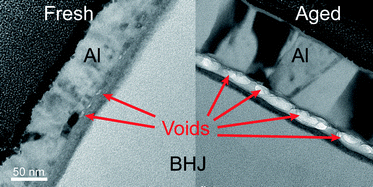Impact of contact evolution on the shelf life of organic solar cells†
Abstract
For organic photovoltaics (OPVs) to become a truly viable technology, it is critical to correctly identify their degradation mechanism(s) and pave the way for strategies to improve device lifetime. Changes in the active organic component are often cited as the leading degradation pathway in OPVs. In this shelf life study, we monitor device performance after storage in the dark at ambient conditions to show that decay behavior is dominated by changes at the top metal electrode and/or the metal–organic interface. Cross-sectional


 Please wait while we load your content...
Please wait while we load your content...